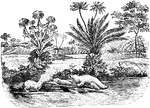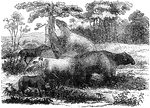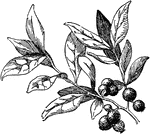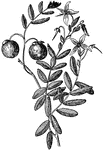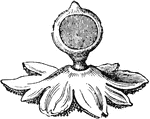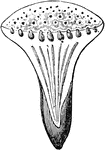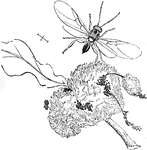
White Snakeroot and Boneset
Of the Composite family (Compositae): left, white snakeroot (Eupatorium urticaefolium); right, boneset…

New York Aster and Tradescant's Aster
Of the Composite family (Compositae): left, New York aster (Aster Novi-Belgii); right, Tradescant's…

Spiderwort
Of the spiderwort family (Tradescantia), clockwise from top: T. bracteata, T. pilosa, T. montana, T.…

Calamites
"Calamites (a restored); b enlarged fig.; c, d, e, leaflets and branches; f catkin; g root." -Taylor,…

Dodder on Golden Rod
"Dodder growing upon a Golden-Rod Stem. s, seedling dodder plants, growing in earth; h, stem of host;…

Grafting
"Grafting. At the left scion and stock are shown ready to be united; at the right they are joined and…

Compass Plant
"Leaves standing nearly vertical in compass-plant. (Silphium laciniatum). A, view from east or west;…
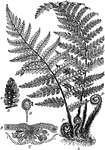
Fern Spore Plant
"Spore-plant of a fern (Aspidium filix-mas). A, part of a rootstock and fronds; fr, young fronds unrollin.…

The Gutta-percha tree
"It is a very large tree, the trunk being sometimes three feet in diameter, although it is of little…

Peppermint
"The mint family of plants, of which the most important species are peppermint, spearmint and penny-royal,…
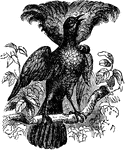
Promerops Superba Bird
" A genus of insessorial birds many of which are remarkable for the beauty of their plumage. They have…

Knight's Experiment
"Knight's experiment, substituting centrifugal "force" for gravity" proved that stems do not grow upwards…

Roman Arm-Chair
The Roman Arm-chair had a decoration symbolic of Ceres, the Roman goddess of growing plants.
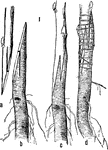
Root Grafting
"Root grafting in its different stages. a, Scion cut for insertion; b, stock prepared to receive the…

Cleft Grafting
"Cleft grafting (Herbaceous). a, Scion ready for insertion; b, stock; c, stock and scion unted; d, the…
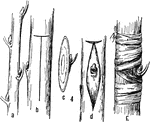
Budding Grafting
"Budding. a, Budstick; b, T-shaped cut in bark of stock; c, bud ready for insertion; d, stock with bud…

Rose Family
"Rosa rugosa, at left; Crataegus punctata, at right. The fruit is composed of the ripened ovary, reinforced…

Section through Antheridium of Liverwort
The Antheridium is the male organ of plants. Within it are produced the sperms or their equivalents,…

Anthoceros Showing Thallus with Two Capsules
A genus of the plants known as liverworts. The body is a simple flat thallus and produces a slender…

Anthoceros, Mature Capsule Splitting
A genus of the plants known as liverworts. The body is a simple flat thallus and produces a slender…
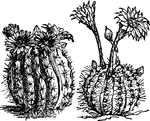
Cacti
These plants have adapted to continuous drought and are able to retain great amounts of water. These…
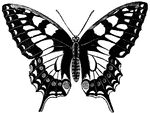
Swallow Tailed Butterfly (Papilio Machaon)
"One of the largest and most beautiful butterflies. It lives on the fennel, carrot and other such plants."

Broomrape (orobanche ramosa).
An annual plant , 6 to 15 inches high, with many slender branches of a brownish or straw color, more…

A Species of Odynerus
"There are solitary wasps which make their cells in holes, which they scoop out in the ground or in…

Larva of the Odynerus Wasp
"There are solitary wasps which make their cells in holes, which they scoop out in the ground or in…

Nest of an Odynerus Wasp in the Stem of a Bramble
"There are solitary wasps which make their cells in holes, which they scoop out in the ground or in…

Larva of Perla Bicaudata
"An insect among the Neuroptera, which undergo incomplete metamorphoses. These flutter about the banks…

Larva of Nemoura
"An insect among the Neuroptera, which undergo incomplete metamorphoses. These flutter about the banks…

Larva of Perla Marginata
"An insect among the Neuroptera, which undergo incomplete metamorphoses. These flutter about the banks…

Bittacus Tipularis
"It resembles a large gnat. They are found on hedges and plants during the summer."

Common Stonewort
"1. Chara vulgaris; 2. a portion of a branch with a nucule and globule; 3. the globule more magnified;…
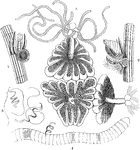
Chara fragilis
"1. Antherid and spore-case of Chara fragilis not much magnified; 2. the same at a later period, after…

Arcyria flava
Arcyria flava (or Arcyria obvelata) is a species of fungus or slime mold found in Australia.

Mucor caninus
Mucor caninus is a species of mold found in soil, on plant surfaces, and rotting vegetables.

Agaricus cepaestipes
Agaricus cepaestipes is a mushroom from a large genus with both edible and poisonous species.

Fungal Disease
Vermicularia trichella is a fungal plant disease that causes leaf and stem spot in English Ivy.
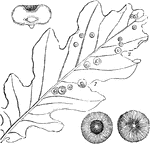
Fungal Diseas
"Mucor mucedo, very highly magnified, exhibiting 1, the spawn or mycelium." -Lindley, 1853

Cordycep
The Sphaeria sinensis a cordycep, a parasitic fungus. "The right hand figure represents the manner in…

Cordycep
The Sphaeria Robertsii a cordycep, a parasitic fungus "growing from the caterpillar of a New Zealand…

Flocci and Spores
"1. Polyplocium inquinans, divided vertically, natural size; 2. flocci and spores; 3 and 4, the same…

Fungus
"Pisomyxa racodioides, Corda.-1. Natural size; 2, the fungus greatly magnified; 3, a spore-case bursting…

Ground Pine
"1. Spore-case of Lycopodium denticulatum opened; 2. antheridium; 3. spore." -Lindley, 1853

